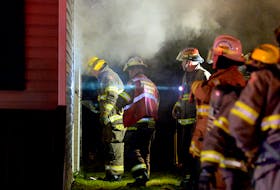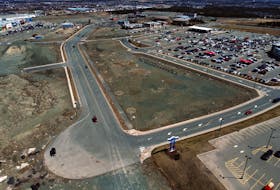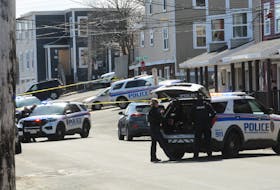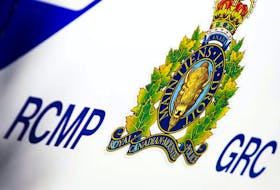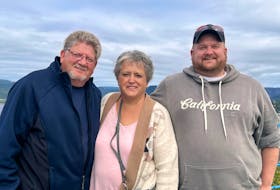Maurice Geange rides shotgun in a small car navigating the gravel road to the Silent Witness Memorial site just east of Gander.
As the car bumps over snow-covered potholes, his eyes are focused on the tree line to the right, where he can still see the “wall of fire”.
It’s been 33 years since the flames were doused, but for the Gander resident, it’s a memory that can never be extinguished.
Geange, an airport firefighter at the time, was part of the first response team for the Arrow Air crash, which killed 248 American soldiers and eight crew, the morning of Dec. 12, 1985.
The soldiers on board were members of the 101st Airborne Division of the U.S. military – also known as the "Screaming Eagles." They were on the final leg of their DC-8 flight back to their home base in Fort Campbell, Kentucky having served a six-month peacekeeping mission on the Sinai Peninsula in the Middle East.
The Canadian Aviation Safety Board wasn’t able to determine what exactly happened, but reported ice contamination on the leading edge and upper surface of the wing as the probable cause.

To this day, it’s the largest aviation disaster to have occurred on Canadian soil.
As the car pulls to a stop, Geange exits the vehicle and makes his way across the bridge to the memorial, he’s standing in the path the aircraft cut through the trees for some 300 yards before coming to a rest and exploding in a ravine near Gander Lake.
He points towards the Trans-Canada Highway (TCH), at the top of the hill, recalling the devastation.
“She must have been all on fire when she struck the top of the hill, and all the way down to where she came to rest,” he said. “Then the fuel must have caught up to her, causing the explosion.”
Aside from the parts that were ripped from the plane as it descended the hill, and a section of cockpit, the aircraft had been completely disintegrated, Geange says.
On the scene, after using his water supply, Geange would be part of a perimeter search for survivors, and it was quickly discovered there would be none.

The bodies of those on the flight, except for a few thrown from the aircraft, were consumed by the flames.
“It’s something that will always be entrenched in my mind,” he says about discovering the bodies. “It’s not something you carry around with you every day, as if it’s tormenting you, but when brought up in conversation it all comes back.”
As he prepares to leave, Geange moves towards the site’s memorial and reviews the names on the granite cenotaph; those the crew wanted to save but were unable to.
Geange wishes it could have been different, but he knows it couldn’t.
“You can sit back and do what if, what if, but we never had a chance with this one,” he said.
Recalling the past
Word of a possible crash reached the fire department at approximately 6:45 a.m., the airport’s firefighting crew was getting ready for a shift change.
Eddie Humphries was on phone watch,
“I was sitting on the chesterfield, after cleaning up, getting ready for the oncoming shift,” said the Northern Arm resident. “All of a sudden there was a yellow flash. People say there was an explosion, but I never heard anything.”
![['An RCMP officer examines the wreckage of an Arrow Air DC-8 jetliner Dec. 13, 1985 — the day after it crashed outside Gander, killing 256 people on board.']](/image/media/photologue/photos/arrow-air-crash-1985-1284878.jpg?cs=srgb&fit=clip&h=700&w=847&auto=enhance%2Ccompress%2Cformat)
Immediately, Humphries knew something was wrong.
He got on the hotline to the tower, trying to piece together what had happened.
Humphries said he was informed there appeared to be a crash at an unknown location and little else was known.
After some discussion, he said, the decision to respond was made.
In slippery conditions, because of freezing rain, a six-person response crew – made up of Humphries, Geange, Doug Massie, John White, Albert Lester and Ernest Anstey – headed down across the runway, cutting through a backroad to gain quicker access to the TCH, coming out directly across from the crash.
After Humphries truck had exhausted its water and foam supply, he and Geange carried out the ground search.
“There was such a tangle of trees and debris, it was hard to do anything,” recalled Humphries. Simply adding, “We didn’t find anybody alive.”
![['A charred American flag is visible on the torn fuselage of Arrow Air Flight 1285 after it crashed near Gander Dec. 12, 1985, killing all 256 people on board. — Transcontinental Media file photo']](/image/media/photologue/photos/arrow-air-a4-dec-6-charred-flag-1286140.jpg?cs=srgb&fit=clip&h=700&w=847&auto=enhance%2Ccompress%2Cformat)
As they continued their work, they would see things that would stay with them for life.
“I saw one fellow, a full-grown man, probably 30 inches long, shrunk with the heat,” he said. “There was another guy sitting up against a tree, not a mark on him, dead. The way he looked, you’d think he was going to talk you, I guess it was the impact (that killed him).”
Humphries attended the scene until 12 p.m. that day, until sent home by the chief because his shift had ended hours before.
Heading back to Northern Arm, he was near the hospital when a car in front of him turned on its turn indicator and he saw the yellow flash of the single light.
“I slammed on the brakes, almost getting into an accident, I guess the yellow light caused a flashback,” he said. “That’s the only time I ever had anything like that happen to me.”
Returning home, his wife Audrey was cooking pork chops.
“When I walked in the house all I could smell was burning flesh, I just about threw up, I had to leave the house,” he said.
Geange too remembers the smell.
“It’s a smell you can’t wash off your clothes, and it takes a long time to get the smell off your body,” he said. “We washed our bunker gear in a solution that Transport Canada got for us, but it couldn’t get rid of the smell. Transport Canada took all the gear and burned it.
“I’ll always smell that, I’ll never forget it. It’s a smell like nothing else.”
Both Humphries and Geange would continue working the crash site scene in the days following, but the full effect of what they had witnessed didn’t really sink in until after their work had been completed.
Geange chalked it up to training.
“At the time, you don’t have time to sit around and think, you train for years for these types of situations,” he said. “When that training kicks in, you become so busy that you don’t even realize what you’re into until after the fact.”
At the time of publication, both the Town of Gander and Fort Campbell were preparing to mark the 33rd anniversary of the Arrow Air crash. This year will be the last official memorial to take place at the original Fort Campbell site as a new memorial is being prepared to honour those who lost their lives.

